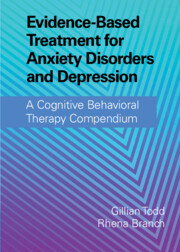 Evidence-Based Treatment for Anxiety Disorders and Depression
Evidence-Based Treatment for Anxiety Disorders and Depression from Part Four - Cognitive Behavioral Therapy for Depression
Published online by Cambridge University Press: 06 January 2022
Cognitive behavioral therapy (CBT) is an effective treatment for perinatal distress. Adapting CBT for perinatal patients requires the clinician to consider characteristics specific to this population. The assessment process must be informed by knowledge of normative changes associated with pregnancy and the early months of parenthood, and treatment strategies may require modification to address challenges related to pregnancy or parenting. This chapter provides an overview of mental health concerns during pregnancy and the early postpartum period, summarizes the research demonstrating the efficacy of CBT in this population, and describes ways in which CBT can be effectively adapted for treating depression and related problems during the transition to parenthood.
To save this book to your Kindle, first ensure [email protected] is added to your Approved Personal Document E-mail List under your Personal Document Settings on the Manage Your Content and Devices page of your Amazon account. Then enter the ‘name’ part of your Kindle email address below. Find out more about saving to your Kindle.
Note you can select to save to either the @free.kindle.com or @kindle.com variations. ‘@free.kindle.com’ emails are free but can only be saved to your device when it is connected to wi-fi. ‘@kindle.com’ emails can be delivered even when you are not connected to wi-fi, but note that service fees apply.
Find out more about the Kindle Personal Document Service.
To save content items to your account, please confirm that you agree to abide by our usage policies. If this is the first time you use this feature, you will be asked to authorise Cambridge Core to connect with your account. Find out more about saving content to Dropbox.
To save content items to your account, please confirm that you agree to abide by our usage policies. If this is the first time you use this feature, you will be asked to authorise Cambridge Core to connect with your account. Find out more about saving content to Google Drive.